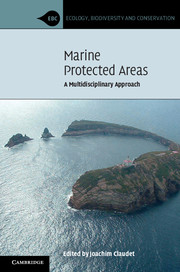Book contents
- Frontmatter
- Contents
- Contributors
- Introduction
- Part I Threats to marine ecosystems and resources
- Part II Effects of marine protected areas
- 2 ECOLOGY – Ecological effects of marine protected areas: conservation, restoration, and functioning
- 3 FISHERIES – Effects of marine protected areas on local fisheries: evidence from empirical studies
- 4 BIOECONOMY – Economically optimal spatial and inter-temporal fishing patterns in a metapopulation
- 5 SOCIO-ECONOMY – Social dynamics of scaling-up marine protected area declarations and management
- Part III Assessment of the effectiveness of marine protected areas
- Part IV Scale-up of marine protected area systems
- Index
- References
4 - BIOECONOMY – Economically optimal spatial and inter-temporal fishing patterns in a metapopulation
from Part II - Effects of marine protected areas
Published online by Cambridge University Press: 05 August 2012
- Frontmatter
- Contents
- Contributors
- Introduction
- Part I Threats to marine ecosystems and resources
- Part II Effects of marine protected areas
- 2 ECOLOGY – Ecological effects of marine protected areas: conservation, restoration, and functioning
- 3 FISHERIES – Effects of marine protected areas on local fisheries: evidence from empirical studies
- 4 BIOECONOMY – Economically optimal spatial and inter-temporal fishing patterns in a metapopulation
- 5 SOCIO-ECONOMY – Social dynamics of scaling-up marine protected area declarations and management
- Part III Assessment of the effectiveness of marine protected areas
- Part IV Scale-up of marine protected area systems
- Index
- References
Summary
Introduction
Over the past two decades, support for the creation of no-take areas as a means to curtail fishing, provide sources of relatively undisturbed habitats, and hedge against the uncertainties inherent in managing complex coupled human–natural systems has grown exponentially (Carr and Reed, 1993; Allison et al., 1998; National Research Council, 2001; Botsford et al., 2003; Gerber et al., 2003). Vocal opponents of marine reserves (i.e., no-take zones) are commercial and recreational fishermen, who already feel overburdened with regulations and are wary of the stated gains from marine reserves (Bernstein et al., 2004). Developing bioeconomic models that illuminate the trade-offs involved in creating a marine reserve can help reduce conflict over contentious sites and avoid disenfranchising various groups in the negotiation process.
Bioeconomic research on the value of using marine reserves for fishery management has focused on measuring the trade-offs in different governance regimes. Under open-access conditions, a typical assessment consists of comparing catch and biomass levels before and after the reserve is created (e.g., Beverton and Holt, 1957; Hannesson, 1998; Pezzey et al., 2000; Sanchirico and Wilen, 2001a; Rodwell et al., 2002; Sanchirico, 2005). Anderson (2002) and Hilborn et al. (2006) analyzed managing fisheries with closed areas and total allowable catches, which is a regulated open-access setting. Other research has investigated creating reserves in limited-entry fisheries where the amount of fishing effort is restricted (e.g., Holland and Brazee, 1996; Hastings and Botsford, 1999; Sanchirico, 2004) and the effects include catches along with profitability of the fishery. Across all of the governance regimes, reserves are beneficial for fishery management when the dispersal benefits (spillover of fish from the reserve to open areas) are greater than the opportunity cost of closing the area (lost catch or profit).
- Type
- Chapter
- Information
- Marine Protected AreasA Multidisciplinary Approach, pp. 99 - 120Publisher: Cambridge University PressPrint publication year: 2011
References
- 2
- Cited by



